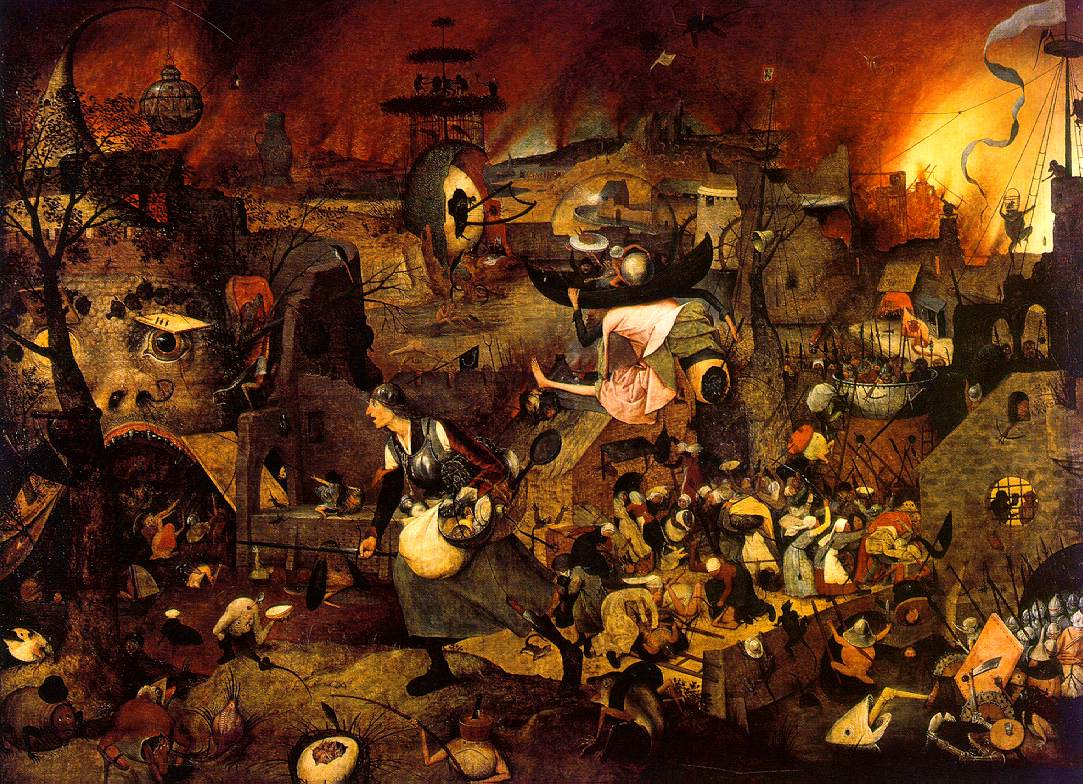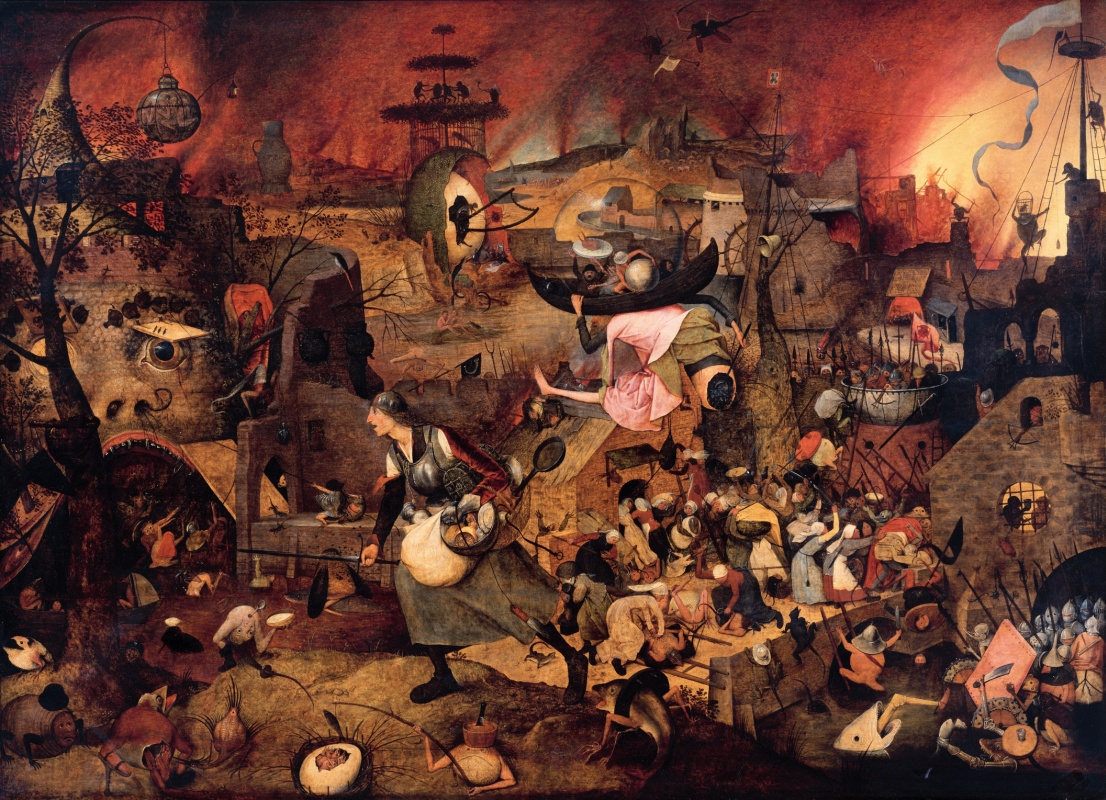log in
Enter site
Login to use Arthive functionality to the maximum
Dull Gret
Pieter Bruegel The Elder • Painting, 1563, 117.4×162 cm
Description of the artwork «Dull Gret»
“Dull Gret” (also known as “Mad Meg”) is a character in the Flemish folklore who embodies greed and vice. This is how they referred to any spiteful and quarrelsome matron with a bad temper. In the painting by Pieter Brueghel the Elder, Gret leads an army of women on their way to plunder Hell. Despite the fact that they had already had a lot of goodness, the subject and her grotesque companions are ready to storm the underworld in search of more.
Gret advances towards the wide mouth of Hell through a landscape inhabited by monster sins. She is wearing a man’s metal bib, glove and helmet. The monster nearby lowering the drawbridge is wearing the same military suit. The dagger on the side of the painting's main subject and the sword in her hand can be a hint of the saying “he could enter Hell with a sword in his hand”. In a book published in Antwerp in 1568, there was a proverb that corresponded to the spirit of the Bruegel’s panel: “One woman makes a din, two women a lot of trouble, three an annual market, four a quarrel, five an army, and against six the Devil himself has no weapon”.
Karel van Mander, the artist’s earliest biographer, described the painting in 1604 as “Dull Gret looking into the mouth of Hell”. It was part of the collection of the Holy Roman Emperor Rudolph II, then it was removed by Swedish troops in 1648, and it reappeared in Stockholm in 1800. Art collector Fritz Mayer van den Berg discovered the panel in 1897 at a Cologne auction and purchased it for some pennies. He discovered the artist’s name a few days later. Now the masterpiece is housed in the collection of the Mayer van den Berg Museum in Antwerp.
A multidisciplinary study and restoration that ended in 2018 revealed that Bruegel did not write the name Dulle (“Dull”) on the panel. This inscription was scrawled later, possibly by accident. The experts also clarified the date when the artwork had been completed — the numbers 1563 showed up after removing several layers of overpainting. Previously, it was believed that the painting had been dated to 1561, given its close compositional and stylistic similarities with "The Fall of the Rebel Angels and The Triumph of Death."
Since in the same 1563 Bruegel moved from Antwerp to Brussels, historians wondered in which of these cities he created this hellish scene. The board on which the picture is painted does not give any clues: the painter used similar panels both before and after this date, and it is unclear where he bought them. It is also unclear how long he worked on his paintings. Was “Dull Gret” completed in Brussels four or five months before the end of the year? Or was it ready in Antwerp before the move? Or did the artist take the unfinished work with him to his new home? These questions remain unanswered so far.
It turned out that, as in other works, Bruegel put a tone of a blend of chalk, white lead and, probably, oil on the white chalk undercoat. Despite the scale and structural complexity of the scene, the underpainting was done economically and accurately; later the master deviated from the original composition in only a few places. The use of paints was also quite traditional: Bruegel painted the background, leaving some space for the motives and details. He undoubtedly knew that colours would retain their original brilliance if he depicted the figures directly on white, and not on a painted background. The layers of paint are extremely thin, no more than two at one point.
Previously, the painting was known for its gloomy strange landscape with a deep red sky and brown strokes. Now it turns out that the two tones on the panel — blue (smalt and azurite) and green — have lost much of their intensity, having changed the overall look of the scene. For example, Gret’s dress and the flag in the upper right corner were originally dark blue. However, they were made with smalt, which was cheaper and more accessible than the extremely expensive lazulite. The azurite pigment (a bright greenish blue) in the sky and the hat of hell also darkened. The green frogs, the foliage on the top left, and the figure on the bottom right have taken on a brownish tint.
After its restoration, the painting looks much fresher and it shows the details that have not been visible for many years, such as finely crafted helmets and a beautiful landscape in the background. The palette turned out to be lighter and more varied, so Bruegel’s brushstrokes and his outstanding skill reappeared. The sense of space is fully restored and the whole scene shows much more depth.
Gret advances towards the wide mouth of Hell through a landscape inhabited by monster sins. She is wearing a man’s metal bib, glove and helmet. The monster nearby lowering the drawbridge is wearing the same military suit. The dagger on the side of the painting's main subject and the sword in her hand can be a hint of the saying “he could enter Hell with a sword in his hand”. In a book published in Antwerp in 1568, there was a proverb that corresponded to the spirit of the Bruegel’s panel: “One woman makes a din, two women a lot of trouble, three an annual market, four a quarrel, five an army, and against six the Devil himself has no weapon”.
Karel van Mander, the artist’s earliest biographer, described the painting in 1604 as “Dull Gret looking into the mouth of Hell”. It was part of the collection of the Holy Roman Emperor Rudolph II, then it was removed by Swedish troops in 1648, and it reappeared in Stockholm in 1800. Art collector Fritz Mayer van den Berg discovered the panel in 1897 at a Cologne auction and purchased it for some pennies. He discovered the artist’s name a few days later. Now the masterpiece is housed in the collection of the Mayer van den Berg Museum in Antwerp.
A multidisciplinary study and restoration that ended in 2018 revealed that Bruegel did not write the name Dulle (“Dull”) on the panel. This inscription was scrawled later, possibly by accident. The experts also clarified the date when the artwork had been completed — the numbers 1563 showed up after removing several layers of overpainting. Previously, it was believed that the painting had been dated to 1561, given its close compositional and stylistic similarities with "The Fall of the Rebel Angels and The Triumph of Death."
Since in the same 1563 Bruegel moved from Antwerp to Brussels, historians wondered in which of these cities he created this hellish scene. The board on which the picture is painted does not give any clues: the painter used similar panels both before and after this date, and it is unclear where he bought them. It is also unclear how long he worked on his paintings. Was “Dull Gret” completed in Brussels four or five months before the end of the year? Or was it ready in Antwerp before the move? Or did the artist take the unfinished work with him to his new home? These questions remain unanswered so far.
It turned out that, as in other works, Bruegel put a tone of a blend of chalk, white lead and, probably, oil on the white chalk undercoat. Despite the scale and structural complexity of the scene, the underpainting was done economically and accurately; later the master deviated from the original composition in only a few places. The use of paints was also quite traditional: Bruegel painted the background, leaving some space for the motives and details. He undoubtedly knew that colours would retain their original brilliance if he depicted the figures directly on white, and not on a painted background. The layers of paint are extremely thin, no more than two at one point.
Previously, the painting was known for its gloomy strange landscape with a deep red sky and brown strokes. Now it turns out that the two tones on the panel — blue (smalt and azurite) and green — have lost much of their intensity, having changed the overall look of the scene. For example, Gret’s dress and the flag in the upper right corner were originally dark blue. However, they were made with smalt, which was cheaper and more accessible than the extremely expensive lazulite. The azurite pigment (a bright greenish blue) in the sky and the hat of hell also darkened. The green frogs, the foliage on the top left, and the figure on the bottom right have taken on a brownish tint.
After its restoration, the painting looks much fresher and it shows the details that have not been visible for many years, such as finely crafted helmets and a beautiful landscape in the background. The palette turned out to be lighter and more varied, so Bruegel’s brushstrokes and his outstanding skill reappeared. The sense of space is fully restored and the whole scene shows much more depth.




